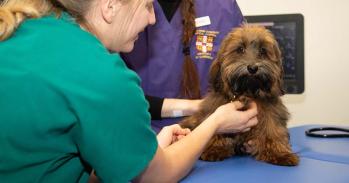
Research by the Department of Engineering and Boeing is taking advantage of the remarkable properties of superconductors.
Research by the Department of Engineering and Boeing is taking advantage of the remarkable properties of superconductors.
By using bearings made from superconductors, it’s possible for the flywheel to be suspended in space by a magnet.
Professor David Cardwell
For almost a century, it’s been known that at temperatures as low as –269°C ‘superconductors’ can carry a DC electric current without losing energy. In some cases, they can carry 100 times more current density (current per unit cross-sectional area) than the copper used in power lines, offering great promise for more-sustainable, energy-related applications.
But it’s not just their conducting properties that make superconductors so attractive: associated with their ability to carry a large electric current is an ability to generate a magnetic field that is sufficiently large to support practical magnetic levitation, an attribute that could be utilised to develop frictionless bearings in devices such as mechanical flywheels.
Professor David Cardwell, who leads the study, explains: ‘Flywheels have long been used to store rotational energy at times when the energy is not needed, in order to release it later – the obvious example being the powering of underground stations. Inevitably, some of this energy is lost through friction at the point of contact between the stationary and the rotating parts of the flywheel. By using bearings made from superconductors, it’s possible for the flywheel to be suspended in space by a magnet, overcoming this energy loss.’
However, a major challenge in realising the potential of bulk superconductors has been the difficulty and cost of mass producing them. Now, Professor Cardwell’s team have found a means to manufacture materials that are cheaper, better and more reliable.
Using high-temperature superconductors such as yttrium barium copper oxide, which requires cooling only to –181°C by relatively inexpensive liquid nitrogen, the Cambridge Bulk Processing Group has developed a means of growing single grains to the size of a hockey puck by partially melting them at around 1,000°C in air, without the need for a controlled processing atmosphere. Crucially, the properties of the resulting material have the required microscopic properties that are essential to maximise the flow of current.
Boeing Flywheel Program Manager Dr Mike Strasik explains the importance of these developments: ‘Being able to make bulk superconductor materials in a practical and economical way that can be scaled up from the laboratory to industry, while maintaining the required superconducting properties, creates a significant market opportunity for a range of emerging engineering applications, such as flywheels.’ The aim now is to improve the properties and production yet further and to work closely with Boeing on application-specific devices.
For more information, please contact Professor David Cardwell (dc135@cam.ac.uk).
Boeing
Boeing is the world’s largest aerospace company and leading manufacturer of commercial aeroplanes and defence, space and security systems. The company strives to work with the best technical talent in developing new aerospace-related technologies and has established multi-year collaborative research relationships with several UK universities, including Cambridge.
With the future of aerospace being driven by developments in technology, Boeing is continually looking globally for new ideas and innovations. To help achieve this, the US-based company has established strategic relationships with universities around the world.
In the UK, Boeing is collaborating through multi-year agreements to conduct research and technology programmes with the University of Sheffield, Cranfield University and the University of Cambridge. Not only are these programmes helping to expand Boeing’s technical reach and business concepts, but they also have long-lasting benefits in helping to stimulate British aerospace innovation.
Boeing’s framework agreement with Cambridge to conduct collaborative research began in 2003 and has recently been extended to 2014. Currently, nine projects are running, involving research teams in the Department of Engineering, the Computer Laboratory and the Department of Social and Developmental Psychology.
The principal focus has been to conduct research and development in areas such as automated reasoning, intelligent systems, natural language and information processing, information manipulation and information security, new materials for high-end engineering, and the interface between humans and computers.
Professor Cardwell, from the Department of Engineering and the lead principal investigator in the collaboration, explains why the relationship with Boeing has proved such an extraordinarily healthy example of industrial collaboration with academia: ‘Boeing facilitate – they make it easy for us to do the academic research that we think is relevant, while keeping in mind the best interests of the company. It’s a very productive, very supportive way of doing research. Their open-minded attitude makes it possible for new objectives to be set as new discoveries are made.’
Applications of the research are as varied as developing new materials for energy-storage systems (see above), assessing the potential of social networking technologies to improve knowledge management and communication in businesses, and improving the operation and security of airports.
For more information about Boeing, please visit www.boeing.com/
This work is licensed under a Creative Commons Licence. If you use this content on your site please link back to this page.





